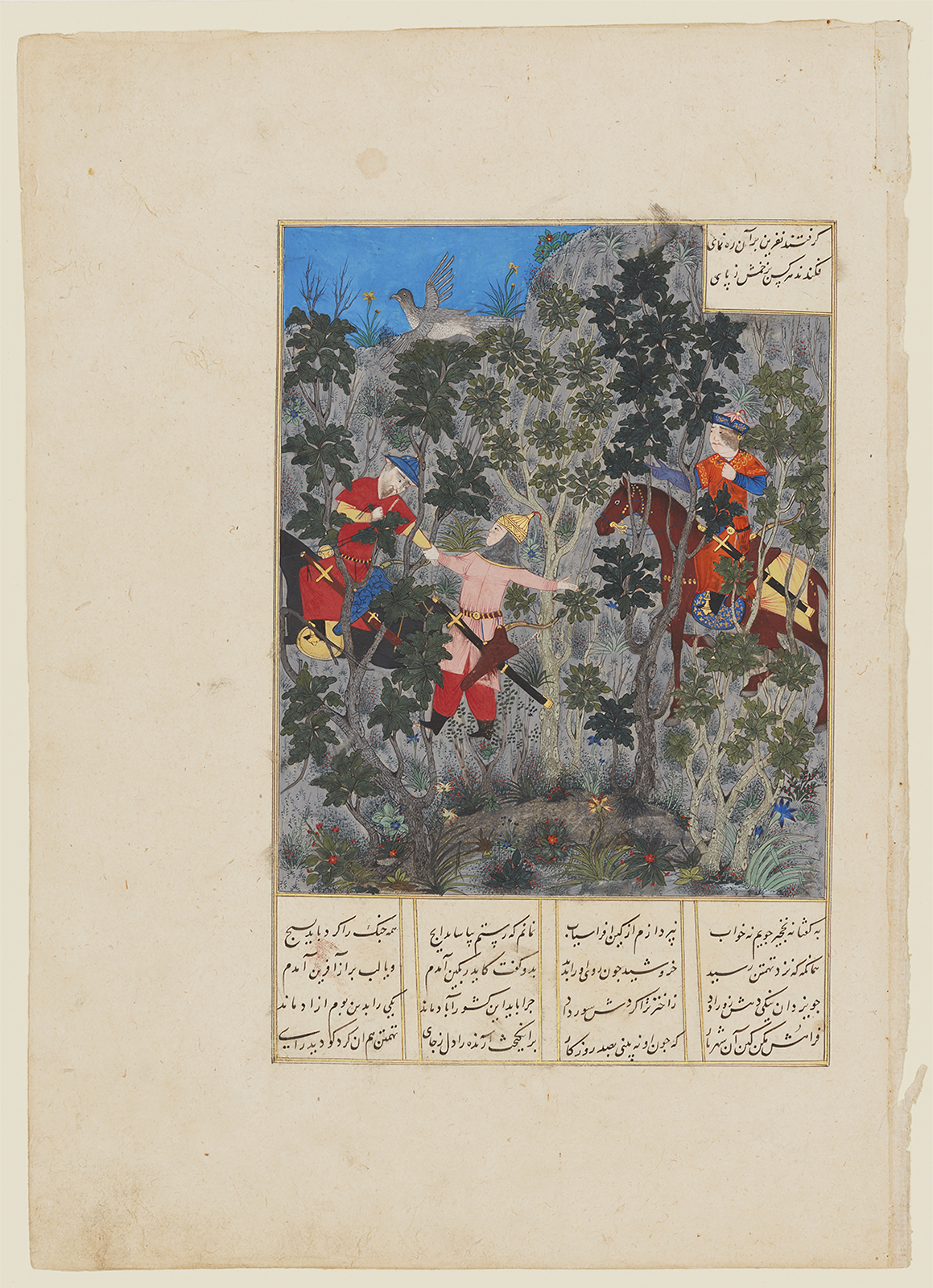
Try Amazon Audible Premium Plus and Get Up to Two Free Audiobooks
Zavara goes to the hunting lodge of Siyavush,
Chapter 12e - Kay Khusrau comes to Iran
Big Head Shahnama, Turkmen, Iran, 1494
Aga Khan Museum AKM91



ZAVARA COMES TO THE HUNTING-GROUND OF SIYAVUSH
FOLIO DETACHED FROM A SHAHNAMEH (BOOK OF KINGS) BY ABU’L-QASIM FIRDAUSI (D. 1010)
Accession Number: AKM91
Creator: Copied by Salik b. Sa‘id, and dedicated to Sultan 'Ali Mirza
Place: Iran, Lahijan
Dimensions: 34.4 x 24.3 cm
Date: ca. 1494
Materials and Technique: opaque watercolour, gold, and ink on paper
Recounting the legendary history of Iran’s shahs (kings) up to the Arab conquest in 642 AD and the country’s adoption of Islam, Firdausi’s epic poem the Shahnameh (Book of Kings), completed in 1010, inspired many illustrated copies. The present folio depicting the hero Rustam’s brother Zavara was detached from a copy that is known as the “Big Head” Shahnameh. This name refers to the characteristic feature of the majority of its paintings: the large heads of its human figures.
Further Reading
The “Big Head” Shahnameh is the only known manuscript from the Aqqoyunlu centre and the only surviving manuscript of the Aqqoyunlu period (1378–1501). Originally, it boasted more than 300 paintings. Many of these paintings illustrated subjects that had never been depicted before; for this reason, the “Big Head” Shahnameh contains newly formulated compositions, which closely follow the text.
The present folio depicts Zavara and his Turkman guide approaching a forest. The guide identifies this forest as the favourite hunting ground of Siyavush, the young Iranian prince who was murdered by the Turanian ruler. [1] Overcome with grief, Zavara releases the hawk perched on his hand and sheds “tears of blood.” When his companions see his tears, they curse the guide and fell him to the ground. There and then, Zavara vows to avenge Siyavush and urges Rustam to do so as well.
The image shows the hunting ground as a lush landscape and closely represents the actions of its protagonists at a specific instant. Zavara is depicted wearing a special hawking glove on his right hand, and the bird is flying away from him. At the same time, one of his companions is pulling the left arm of the Turkman guide and is about to fell him to the ground.
The “Big Head” Shahnameh is today preserved in two separate collections in Istanbul: volume one, in the Türk ve Islam Eserleri Müzesi (TIEM, ms. 1978, formerly Evkaf, Halet Efendi 3079) and volume two, in the Istanbul University Library (F. 1406, formerly Yildiz 7954/310). The first volume bears a dedication to a Sultan ‘Ali Mirza (TIEM 1978, fol. 1a), while the second volume ends with a colophon which gives the name of the dedicatee as Mirza ‘Ali, as well as the name of the scribe, Salik b. Sa‘id, and the date 899/1494 (IUK F. 1406, fol. 304r). Over 40 illustrated folios from the first volume appear to have been removed and are now found in diverse collections worldwide.
The patron of the manuscript is identified by common consensus in art historical literature as the Shi’ite governor of Gilan, Mirza ‘Ali, from the Karkiya dynasty (r. 1478–1505), whose patronage is otherwise unknown. According to Charles Melville, he is consistently referred to as Mirza ‘Ali in the contemporary sources, as in the colophon of volume two, even though he is called Sultan ‘Ali Mirza in the dedication of volume one, as well as in the secondary literature. [2]
Mirza ‘Ali’s rule covered the crucially important period of the 1501 Safavid takeover of western Iran from the Aqqoyunlu Turkmans (1467–1501). Furthermore, the grandson of the Aqqoyunlu ruler and the future founder of the Safavid dynasty (1501–1724), Isma‘il Safavi, took refuge at the court at Lahijan around the year 1493–94, either just before the beginning or during the production of the “Big Head” Shahnameh. The manuscript thus seems to have been produced and illustrated at exactly the period when the future Safavid shah was at Mirza ‘Ali’s court, which raises the possibility that its creation may be connected to Isma’il’s sojourn in the area.
The Aga Khan Museum has five “Big Head” Shahnameh folios, see AKM62, AKM63, AKM64 and AKM92.
— Lale Uluc
Notes
[1] Jules Mohl, ed., Shahnama-i Firdausi, 3 vols. (Tabriz: Chapkhana-i Maharat, 1370/1991), 1: 123, verses 691–700; A.G. Warner and E. Warner, trans., The Shahnama of Firdausi, 9 vols. (London: Kegan Paul, 1905–25), 1: 210.
[2] For further reading and all references, see Charles Melville, “The ‘Big Head’ Shahnama in Istanbul and elsewhere: Some codicological and iconographical observations,” (forthcoming).
Source: Aga Khan Museum AKM91
Geneva, Aga Khan Trust for Culture
Title of Work: Shahnama (Big Head)
Manuscript: 2005.1.62-64, 91-92 (Ir.M. 17-17/B, 60-60/A)
Accession Number: 2005.1.91 (Ir.M. 60)
Chapter 12e - Kay Khusrau comes to Iran
Scene: Zavara goes to the hunting lodge of Siyavush
Dimensions (h x w): 187 x 153 mm
Format: Stepped within borders
Hijri Date: 899
Gregorian Date: 1493 (to nearest hijri year)
School: Turkman Commercial Style
Source: Shahnama Project